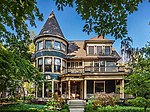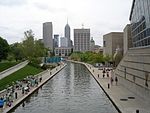Arsenal Technical High School

Arsenal Technical High School, commonly referred to as Tech or Arsenal Tech, is a public high school in Indianapolis, Indiana, United States, which is run by the Indianapolis Public Schools district. The school is located on a 76-acre (31 ha), multiple building campus east of downtown Indianapolis, and is the only such type school in Indiana. The school's campus originally served as a U.S. Civil War era arsenal from 1864 until 1903, when it was closed following the Spanish–American War. A few years later, the school opened in 1912 under founder Milo H. Stuart. A number of extant buildings dating back to military use are still open and serve academic purposes for the school, such as the Arsenal building and the Barracks. In addition, a number of additional buildings were built in the following decades to accommodate the school's functions. Due to the significance of the school's campus, facilities, and history, Arsenal Technical was placed on the National Register of Historic Places in 1976. Arsenal Technical offers four academic programs at the school. These include the New Tech program, the Math and Science program, the Law and Public Policy program, and the Career Technology Center.
Excerpt from the Wikipedia article Arsenal Technical High School (License: CC BY-SA 3.0, Authors, Images).Arsenal Technical High School
North Oriental Street, Indianapolis Cottage Home (Near Eastside)
Geographical coordinates (GPS) Address Nearby Places Show on map
Geographical coordinates (GPS)
| Latitude | Longitude |
|---|---|
| N 39.777777777778 ° | E -86.133055555556 ° |
Address
North Oriental Street
46202 Indianapolis, Cottage Home (Near Eastside)
Indiana, United States
Open on Google Maps








